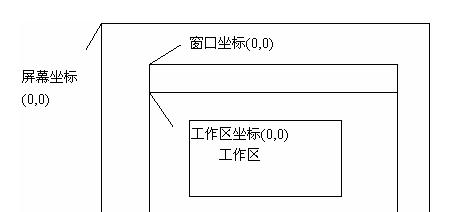- ClientToScreen
- 首页
-
- 百科
-
- 发动机系统
-
- ClientToScreen

ClientToScreen
基本内容
函数原型:BOOL ClientToScreen(HWND hWnd,LPPOINT lpPoint);
参数:
:用户区域用于转换的窗口句柄。
:指向一个含有要转换的用户坐标的结构的指针,如果函数调用成功,新屏幕坐标复制到此结构。
返回值:如果函数调用成功,返回值为非零值,否则为零。
注释:函数用屏幕坐标取代POINT结构中的用户坐标,屏幕坐标与屏幕左上角相关联。
速查:Windows NT:3.1及以上版本;Windows:95及以上版本;Windows CE:1.0及以上版本;头文件:winuser.h;库文件:user32.lib。
相近用法
ClientToScreen 和ScreenToClient函数的用法相近,但是也有一定区别:
ClientToScreen( )是把窗口坐标转换为屏幕坐标
ScreenToClient( )是把屏幕坐标转换为窗口坐标
屏幕坐标是相对于屏幕左上角的,而窗口坐标是相对于窗口用户区左上角的
VC下,有些函数使用窗口坐标,有些使用屏幕坐标,使用时要分清。
一个窗体分为两部分:系统区和客户区
象标题和菜单之类的是系统区,由系统来控制,客户区就是你的地盘喽!!!
Width, Height 是指整体的,ClientWidth, ClientHeight是指客户区的,两者相减就是
系统区的啦!!!
ClientToScreen是把坐标从当前窗体转化成全屏幕的!!!
ScreenToClient是把屏幕坐标转化成相对当前窗体的坐标!!!!
 ClientToScreen 和ScreenToClientbool m_bIsLButtonDawn =false;
ClientToScreen 和ScreenToClientbool m_bIsLButtonDawn =false;
void CDrawDlg::OnMouseMove(UINT nFlags, CPoint point)
{
// TODO: Add your message handler code here and/or call default
CWnd *pwnd=GetDlgItem(IDC_EDIT1);
CDC *pdc=pwnd->GetDC();
CRect rect;
this->ClientToScreen(&point);
pwnd->ScreenToClient(&point);
pwnd->GetClientRect(&rect);
// HCURSOR hcur=::LoadCursorFromFile("pen.cur");
// SetClassLong(GetSafeHwnd(),GCL_HCURSOR,(LONG)hcur);
// CPen pen(PS_INSIDEFRAME,-1,RGB(255,255,255));
// CPen* olePen=pdc->SelectObject(&pen);
if(rect.PtInRect(point) && m_bIsLButtonDawn )
{
pdc->DPtoLP(&m_fp);
pdc->MoveTo(m_fp);
pdc->DPtoLP(&point);
pdc->LineTo(point);
}
m_fp=point;
// pdc->SelectObject(olePen);
ReleaseDC(pdc);
CDialog::OnMouseMove(nFlags, point);
}
void CDrawDlg::OnLButtonUp(UINT nFlags, CPoint point)
{
m_bIsLButtonDawn =false;
// TODO: Add your message handler code here and/or call default
/**//*
CWnd *pwnd=GetDlgItem(IDC_EDIT1);
CDC *pdc=pwnd->GetDC();
CRect rect;
this->ClientToScreen(&point);
pwnd->ScreenToClient(&point);
pwnd->GetClientRect(&rect);
if(rect.PtInRect(point))
{
pdc->DPtoLP(&m_fp);
pdc->MoveTo(m_fp);
pdc->DPtoLP(&point);
pdc->LineTo(point);
}
ReleaseDC(pdc);*/
CDialog::OnLButtonUp(nFlags, point);
}
void CDrawDlg::OnLButtonDown(UINT nFlags, CPoint point)
{
// TODO: Add your message handler code here and/or call default
CWnd *pwnd=GetDlgItem(IDC_EDIT1);
CDC *pDC=pwnd->GetDC();
CRect rect;
this->ClientToScreen(&point);
pwnd->ScreenToClient(&point);
pwnd->GetClientRect(&rect);
if(rect.PtInRect(point))
{
m_fp.x=point.x;
m_fp.y=point.y;
}
ReleaseDC(pDC);
m_bIsLButtonDawn =true;
CDialog::OnLButtonDown(nFlags, point);
}

-
江铃福特轻客持续打造最优TCO 锐骐超值版PK江铃国产共轨
2025-09-19 15:05:43 查看详情 -
江铃福特轻客持续打造最优TCO 江铃E200N豪华型怎么样
2025-09-19 15:05:43 查看详情 -
380TSI劲擎智联版四驱车型上市 成都车展:雪铁龙C
2025-09-19 15:05:43 查看详情 -
PRO上市 售价9.48万
2025-09-19 15:05:43 查看详情 -
Plus上市 别克昂科威S及昂科威S艾维亚将于7月29日上市
2025-09-19 15:05:43 查看详情 -
全新紧凑型SUV/上半年上市 别克昂科拉PLUS最新谍照
2025-09-19 15:05:43 查看详情 -
黄海纯电轿车Smile将于12月上市 29万元
2025-09-19 15:05:43 查看详情 -
江铃宝典堪称商用皮卡常青树 江铃新宝典VS长城风骏7(图文)
2025-09-19 15:05:43 查看详情 -
欧拉新款R1将于成都车展上市 全新宝马2系Coupe最新谍照
2025-09-19 15:05:43 查看详情 -
西安大众速腾现金优惠2.3万 成都沃尔沃XC90优惠三万元
2025-09-19 15:05:43 查看详情


 求购
求购

